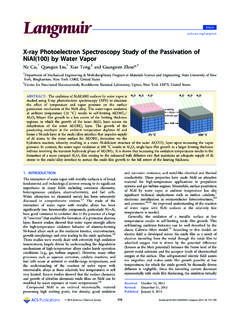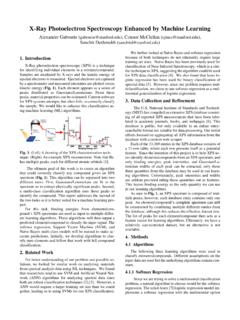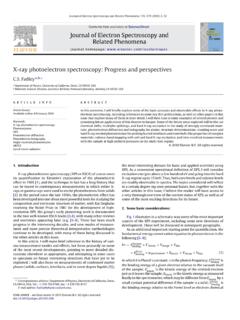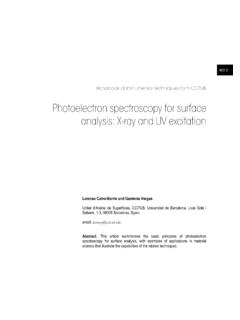Transcription of Introduction to X-ray Photoelectron Spectroscopy
1 A Shimadzu Group CompanyA Shimadzu Group CompanyIntroduction to X-ray Photoelectron is the surface? What happens at surfaces is extremely important in a vast What happens at surfaces is extremely important in a vast range of applications from environmental corrosion to medical implants. A surface can be thought of as the interface between different phases (solid, liquid or gas). We can think of the surface as the top layer of atoms but in We can think of the surface as the top layer of atoms but in reality the state of this layer is very much influenced by the 2 10 atomic layers below it (~ 3 nm). Surface modification treatments are often in the range of 10 100 nm thick. >100 nm can be thought of as the analysis encompasses techniques which probe the Surface analysis encompasses techniques which probe the properties in all these Shimadzu Group CompanyA Shimadzu Group Company2 Why is Surface Analysis Important?
2 Scale of surface region: 002 Surface: typically controls chemical0 nm0 to 10 nm> 10 nmBulk material: controls materials physical properties density, strength, flexibility Surface: typically controls chemical interaction with other materials and ,g , surface of the material is very often chemically distinct from the bulk material and standard analytical techniques can not provide any information about it s Shimadzu Group CompanyA Shimadzu Group Company3 Elemental analysis of the outermost atomSURFACE SCIENCES urface ..what it means Elemental analysis of the outermost atom layer Detail knowledge of the Chemical Binding micronstate Surface homogeneity Nature of absorbates10 nm Surface characteristics has great impact : example : adhesion, bond-ability, reactions, etc. Depth profiling* By sputtering in situ1 nm Information on atomic layers below the surface as a function of depth Destructive or nondestructiveA Shimadzu Group CompanyA Shimadzu Group Company05-10-2017 Introduction4 What does a surface technique do ?
3 Qualitative Qualitative Quantitative, semi-quantitative Chemical bondingArea of Interest Mapping (Scanning ESCA/Auger/TOF-SIMS/FTIR/EDX/WDX) Depth profilingFilhi k( hi fil )surfaceD,thickness Film thickness ( thin film)BULKL ateral: 10 microns to a few hundred micronsA Shimadzu Group CompanyA Shimadzu Group Company05-10-2017 Introduction5 Depth : < 5 nmSurface Analysis - Techniques Available Properties and reactivity of the surface will depend on: bonding geometry of molecules to the surface physical topographyphysical topography chemical composition chemical structure atomic structurephotonsionsltEMISSIONEXCITATION atomic structure electronic stateelectronsInteractionNo one technique can provide all these pieces of information. However, to solve a specific problem it is seldomInteraction with materialsolve a specific problem it is seldom necessary to use every technique Shimadzu Group CompanyA Shimadzu Group Company6 TRANSMISSIONF igure Generalized illustration of interaction volumes for various electronspecimen interactions1.
4 Pls take note of the effective volumes for various electron-specimen interactions. Auger electrons (not shown) emerge from a very thin region of the sample surface (maximum depth about 50 ) than do secondary electrons (50-500 ).beam diameter ( influencing the spot size)2. common SEM with a spot beam of about 5 nm, the diameter ofof about 5 nm, the diameter of the volume sampled, the so-called interaction volume may be up to 5 hundred times larger3It id bl is caused by electrons, and other resulting radiations scattering and diffusing thru the sample, before emerging and p,ggbeing detectedA Shimadzu Group CompanyA Shimadzu Group Company05-10-2017 AltilThiSil MdElt l RDthR ltiSf ifSurface Analysis - Techniques AvailableAnalytical Technique Signal Measured Elemental Range Depth Resolution Surface info. SIMS Secondary Ions H-U 5 - 30 Chemical composition(secondary ion mass spectrometry)Chemical structureTOFSIMSSO (S)TOF-SIMSS econdary Ions H-U, Large Organic 2000 (Scanning Mode) Adsorbate bonding(time-of-flight SIMS)Molecules / Cluster IonsTEM Transmitted Electrons X-Rays Na-U EDX N/A (transmission electron microscopy)FE-SEM, EDXB ackscattered or Na-U 1 - 5 micrometres (field emission SEM)Secondary Electrons and X-Rays ISSIonsH- Umonolayeratomic structure(ion scattering Spectroscopy )chemical compositionAES/SAMA uger Electrons Li-U1 - 5 nm chemical composition (Auger electron Spectroscopy , scanning Auger microscopy)(gppyg gpy)
5 ESCA/XPSP hotoelectrons Li-U 1 10 nmchemical composition (electron Spectroscopy for chemical analysis, X-ray Photoelectron Spectroscopy )chemical structureRAIRSIR photonsorganic, some inorganicsmonolayerAdsorbate bonding(reflection-absorption infra-red Spectroscopy )STMsolid surfacesupper most atomsphysical topographySTM-solid surfacesupper most atomsphysical topography(scanning tunnelling microscopy)Analytical TechniqueSignal MeasuredElemental Range Depth Resolution Surface info,A Shimadzu Group CompanyA Shimadzu Group Company8 Surface Analysis - Techniques AvailableA Shimadzu Group CompanyA Shimadzu Group Company9 Surface Analysis - Techniques AvailableA Shimadzu Group CompanyA Shimadzu Group Company10 Acronyms & Definitionsy AESA uger electron spectroscopyBEBi di( V) BEBinding energy (eV) eVelectron volt FWHM full width half maximum IMFPI nelastic mean free path length ISSIon scattering Spectroscopy KEKinetic energy (eV) SAMscanning Auger microscopy SEMS econdary electron microscopy SIMSS econdary ion mass spectrometry ToFTime of flight UPSU ltra violet Photoelectron Spectroscopy XPSX-ray Photoelectron spectroscopyA Shimadzu Group CompanyA Shimadzu Group Company11 ESCA/XPS XPS or ESCA ?
6 Why ? Used as an analytical toolXPS or ESCA ? Why ? Initial name given is XPS : X-ray Photoelectron Spectroscopy . Work mostly done by Physicists in the early 50. Wilson Chamber experiment, etc Photoelectric effect Einstein 1921 Nobel prize Used as an analytical tool Surface sensitive Qualitative ( elemental analysis) Quantitative Einstein, 1921 Nobel prize Interpretations and applications pioneered by the Chemists mid Professor Kai Siegbahn coined the name Electron Spectroscopy for Chemical Analysis,ESCA ( note: the Professor was awarded a Nobel prize for Insight into the chemical state of sample (chemical bonding) Imaging capability( note: the Professor was awarded a Nobel prize for his work in this area,1981 Photo- electronIncoming X-raye-nucleusA Shimadzu Group CompanyA Shimadzu Group Company05-10-2017 Photo emission processe, Photoelectron The surface is bombarded by the monoenergetic X-ray , emitting a Photoelectron This Photoelectron can be analysed and used ( we have the XPS/ESCA)X ray the XPS/ESCA) What happens to the excited atom ?)
7 It would undergo a relaxation process as the excited atom is unstable See next slide for the relaxation p3sEf0 BEValence bandThe BE is now taken to be a direct fthi dt j t relaxation by a X ray fluorescence relaxation by an Auger electron escaping s s delectronmeasure of the energy required to just remove the electron concerned from its initial level to the vacuum level and the KE of the Photoelectron is again given by #The Energy is given by Einstein's equation #: E = h andA Shimadzu Group CompanyA Shimadzu Group Company05-10-2017 ESCA/XPS13h = + + work functionAuger Electron Emission ProcessX-ray Fluorescence, XRFE nergy level transition forming X-ray fluorescence analysis XRF. The energy of the released x ray is independent of the incident x rayvacuumWhen the electronic transition occurs,energy is conserved by the emission of a photon ( x ray).the other process is a radiation-less transition ,see the next slideValence bandFermi levelESCA instrument does not have a X-ray detector to collect the secondary x-rayL(2 )L23(2p)detector to collect the secondary X-ray signalsEXRFK (1s)L1(2s)A Shimadzu Group CompanyA Shimadzu Group Company05-10-2017 ESCA/XPS14 The Auger electron processNomenclature.
8 Auger line XYZvacuumA Core hole in level X is filled by an electron in level Y and an electron is ejected from level ZAuger electron, KL1L23E = EK-EL1-EL23+ QValence bandFermi levelIn addition to the Photoelectron emitted in the photoelectric process, Auger electrons are emitted due to relaxation of the energetic ions remained afterL(2 )L23(2p)due to relaxation of the energetic ions remained after the Auger electron emission occurs roughly 10-14seconds after the photoelectric effectIhAhlEK (1s)L1(2s)In the Auger process, as shown, an outer electron gets into the inner orbital vacancy,and the second electron is emitted carrying off the excess energy ( kinetic energy of the auger electronA Shimadzu Group CompanyA Shimadzu Group Company05-10-2017 ESCA/XPS15 Note on Auger electron emission The Auger process can occur anytime we create a hole in a core orbital (level) Holes are created using x-rays ( in ESCA) , electrons ( in AES), ions ( in SIMS), and others Auger electron signals provides supplementary information Auger electron signals provides supplementary information in a ESCA spectrum AES also provides an alternative stand-alone surface analysis tool (to be elaborated later) Use electron beam as a probe Spot size of the electron beam can be as small as 50-100 nmSpot size of the electron beam can be as small as 50100 nm, hence useful as an analysis tool for the area of interest on a sample with <1 micronA Shimadzu Group CompanyA Shimadzu Group Company05-10-2017 ESCA/XPS16 How ESCA works It involves irradiating a solid in vacuo,with mono-energetic soft x-rays.)
9 The X-rays interact with atoms in this surface region by photo electric effect,causing electrons to be emitted. Core electrons are involved The emitted electrons have kinetic energy defined by Einstein equation :gyy E = h = + + Where E is the energy of the photon ( X-ray ) BE= the binding energy of the ejected Photoelectron KE = the kinetic energy of the ejected Photoelectron ( measured by electron KE = the kinetic energy of the ejected Photoelectron ( measured by electron analyzer) = the spectrometric work function using soft (200-2000 eV) X-ray excitation to examine core-levelsThe Mg and Al Kxrays are chosen as radiation source Both have limited The Mg and Al K x-rays are chosen as radiation source . Both have limited penetrating power monochromatic radiation Mg K = Al K x rays = 1486 eVBi diiht i tiflt N tththtt Binding energy is a characteristic of an two atoms have the exact set of values of their atomic binding energies.)
10 Hence, ESCA can be used for elemental analysis. Involves 3 electrons. Applicable to Li and t ft (I tit )Bi diA Shimadzu Group CompanyA Shimadzu Group Company05-10-2017 ESCA/XPS17 ESCA spectrum is a plot of counts (Intensity) versus Binding energy Intensity ,in general , indicates the amount of the element presentTypical Sampling Depths of Techniquesact angleSIMSFMSanMSESRMTop surfaceNear surfaceISSC ontaTOF XPSAESTXRFSEMGDMRamaRBSICPMLEXEXRRFTIRED SSTEMXRDXRF3 nmNear surfaceThin filmCoating10 nm100 nmCoatingBulk substrate1,000 nmA Shimadzu Group CompanyA Shimadzu Group CompanyThe X-ray Photoelectron Spectroscopy Experiment Prof. Kai Siegbahn, (1918 2007) Uppsala University, idththifpioneered the technique of XPS, producing the first well defined spectrum in 1954. He shared the 1981 Nobel He shared the 1981 Nobel prize in physics for his work in Spectroscopy . Since then the basic building blocks of the X-ray Photoelectron spectrometer have not t hl However, UHV technology and electronics have improved!









